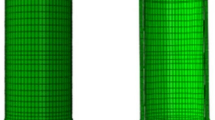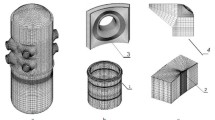Along with the classical finite element method (FEM), other calculation methods for assessing crack resistance characteristics are currently being actively developed. This is due to the existing shortcomings of the FEM caused by the dependence of the calculation results on the density of the finite element mesh. One of the promising methods being developed in world practice is the extended finite element method (XFEM), which allows obtaining satisfactory calculation results while simplifying the crack modeling procedure and saving calculation time. In this paper, three problems are numerically modeled using the classical FEM and XFEM methods: calculation of a disc crack in a cube under uniaxial tension, calculation of the off-center tension of a compact CT specimen, and calculation of a cylindrical part of an NPP reactor vessel with a semi-elliptical crack under thermal shock. The obtained results showed that the extended finite element method gives sufficiently accurate results compared to analytical solutions and the classical FEM. At the same time, using the XFEM method does not require considering the singularity of stresses at the crack tip when building an FE model. Therefore, the minimum size of the FE can be increased by almost five times while maintaining the accuracy of the results. This greatly simplifies the procedure for constructing the FE mesh, reduces the total number of FEs in the model, and saves computational time. Thus, the XFEM method can be used to calculate the crack resistance characteristics and improve the efficiency of assessing the resistance to brittle fracture of structural elements.












Similar content being viewed by others
References
V. V. Kharchenko, A. Yu. Chirkov, S. V. Kobelskyi, and V. I. Kravchenko, Methods of Computational Analysis in Problems of Strength of Equipment Elements of WWER Reactor Plants [in Ukrainian], Pisarenko Institute of Problems of Strength, National Academy of Sciences of Ukraine, Kyiv (2018).
V. V. Kharchenko, V. A. Piminov, A. Yu. Chirkov, et al., “Elastoplastic fracture resistance analysis of NPP primary circuit equipment elements,” Strength Mater, 45, No. 4, 397–405 (2013). https://doi.org/https://doi.org/10.1007/s11223-013-9472-z
S. Choi, H. B. Surh, and J. W. Kim, “Effect of postulated crack location on the pressure temperature limit curve of reactor pressure vessel,” Nucl Eng Technol, 51, No. 6, 1681–1688 (2019).
E. O. Kondryakov, “Application of modern approaches to the numerical modeling of the stress-strain state for the strength assessment of complex units of the NPP primary circuit equipment. Part 1. Submodeling methodology,” Strength Mater, 54, No. 6, 1057–1063 (2022). https://doi.org/https://doi.org/10.1007/s11223-023-00481-z
T. Belytschko and T. Black, “Elastic crack growth in finite elements with minimal remeshing,” Int J Num Meth Eng, 45, 601–620 (1999).
J. M. Melenk and I. Babuška, “The partition of unity finite element method: Basic theory and applications,” Comput Method Appl M, 139, Nos. 1–4, 289–314 (1996).
X. Sun, G. Chai, and X. Li, “Effect of plasticity of the cladding with different thicknesses on the bearing capacity of the brittle base wall of RPV under PTS loads,” Heliyon, 9, No. 3, e14902 (2023).
R. Bashir, H. Xue, J. Zhang, et al., “Effect of XFEM mesh density (mesh size) on stress intensity factors (K), strain gradient (dε/dr) and stress corrosion cracking (SCC) growth rate,” Structures, 25, 593–602 (2020).
D. F. Mora, M. Niffenegger, G. Qian, et al., “Modelling of reactor pressure vessel subjected to pressurized thermal shock using 3D-XFEM,” Nucl Eng Des, 353, 110237 (2019).
A. Muixi, M. A. Marco, O. Rodríguez-Ferran, and S. Fernández-Méndez, “A combined XFEM phase-field computational model for crack growth without remeshing,” Comput Mech, 67, 231–249 (2021).
M. Lin, S. Agbo, J. Cheng, et al., “Application of the extended finite element method (XFEM) to simulate crack propagation in pressurized steel pipes,” in: Proc. of the ASME 2017 Pressure Vessels and Piping Conference, Volume 3B: Design and Analysis (July 16–20, 2017, Waikoloa, Hawaii, USA). https://doi.org/10.1115/PVP2017-65575
Y. Murakami, Stress Intensity Factors Handbook, Vol. 3, The Society of Materials Science, Kyoto, Japan (1992).
ASTM E1921-03. Standard Test Method for Determination of Reference Temperature, T0, for Ferritic Steels in the Transition Range, ASTM International, West Conshohocken, PA (2003).
F. Li, C. Shih, and A. Needleman, “A comparison of methods for calculating energy release rates,” Eng Fract Mech, 21, No. 2, 405–21 (1985).
Author information
Authors and Affiliations
Corresponding author
Additional information
Translated from Problemy Mitsnosti, No. 5, pp. 16 – 26, September – October, 2023
Rights and permissions
Springer Nature or its licensor (e.g. a society or other partner) holds exclusive rights to this article under a publishing agreement with the author(s) or other rightsholder(s); author self-archiving of the accepted manuscript version of this article is solely governed by the terms of such publishing agreement and applicable law.
About this article
Cite this article
Kondryakov, E.O. Application of Modern Approaches to the Numerical Modeling of the Stress-Strain State for the Strength Assessment of Complex Units of the NPP Primary Circuit Equipment. Part 2. Extended Finite Element Method. Strength Mater 55, 888–897 (2023). https://doi.org/10.1007/s11223-023-00579-4
Received:
Published:
Issue Date:
DOI: https://doi.org/10.1007/s11223-023-00579-4




